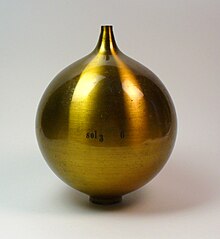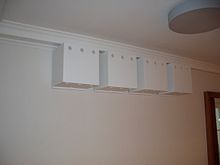Helmholtz resonator
A Helmholtz resonator (named after Hermann von Helmholtz ) is an acoustic resonator . The layman should know it from everyday life as a bottle that produces a sound when blown on the neck . Helmholtz developed this resonator in 1859 in order to use his ear to detect a single fundamental tone from a mixture of sounds that penetrates the lower opening. The resonator was initially blown from glass and later formed from sheet brass .
Layout and function
A Helmholtz resonator consists of a volume of air in any shape, which has a narrow, cylindrical, short neck with an opening to the outside. The inert mass of the air in the throat is:
With
- Density of air
- Length of the neck
- Cross-sectional area of the opening.
The combination of this mass with the elasticity of the entire volume of air creates a mechanical mass-spring system with a pronounced natural frequency , whereby the spherical shape is assumed. Bottles or cuboids already have several natural frequencies. A cube is the closest thing to a spherical shape.
The spring constant of the mass-spring system can be calculated depending on the cross-sectional area and the enclosed air volume:
With
- the speed of sound .
Thus, for the resonance circular frequency of the system:
and consequently for the resonance frequency :
The flow velocity at the neck of the resonator changes smoothly and not abruptly (as assumed in this derivation). The neck forms a resonator that is open on both sides. As a result, the resonator neck length at the ends must be increased by the amount known as the end correction of the resonator length or muzzle correction :
Helmholtz stated when the neck is short and has the radius R. The muzzle correction depends on the shape and design of the muzzle (round, angular, slot-shaped).
Musical instruments
Helmholtz resonators are built into a bass marimba especially for low tones . They have the advantage of small dimensions compared to cylindrical resonators. Djembé , Ghatam , Udu and Hang also use the properties of a Helmholtz resonator, among other things. With the Gubal , a further development of the Hang, different bass notes can be played by manipulating the neck with the hand.
As an absorber in room acoustics
Helmholtz resonators can be used as resonance absorbers in noise protection and room acoustics to absorb narrow-band, low-frequency room modes , e.g. B. in concert halls, theaters, studios, schools, office and conference rooms. They can be a visible part of the interior design or they can be concealed behind an open false ceiling (see also acoustic ceiling ).
In contrast to porous absorbers, with which they can be combined, resonance absorbers essentially consist of a mass and a spring . The sound energy that hits it is converted into kinetic energy of the vibrating mass.
Both plates ( plate oscillators , e.g. made of plywood , plasterboard , pressboard , synthetic leather or foil) and, in the case of perforated plates, the air oscillating in the hole (perforated plate oscillators and Helmholtz resonators) can be used as the mass . The volume of air enclosed behind the plate acts as a spring.
The maximum absorption occurs at the frequencies at which the mass vibrates most strongly, i.e. in the frequency range of natural resonance , which is mostly at low frequencies. In contrast, the sound is only slightly attenuated at medium and high frequencies .
In order to describe the absorption capacity of a resonance absorber , however, knowledge of the resonance frequency alone is not sufficient. The absorption capacity is also influenced by (see membrane absorber ):
- the equivalent sound absorption area
- the quality that describes the bandwidth over which a resonator draws energy from the sound field
- The arrangement of the resonator in the room: in the edges of the room the effectiveness is greater than in the middle of the room surfaces. This is why it is most effective when it is arranged in the corners of the room. If several resonators are used, they can be arranged next to one another on the closed surfaces.
In addition to the passive Helmholtz resonators described, there are also active variants which are characterized by high efficiency and small dimensions.
Loudspeaker boxes
Helmholtz resonators , see the loudspeaker for a long time in the form of bass reflex enclosures use. In 2003, the developer Bernd Timmermanns presented the possible uses of an internal Helmholtz absorber to suppress individual standing waves within loudspeaker housings of any type.
literature
- Thomas Görne: Sound engineering. 1st edition, Carl Hanser Verlag, Leipzig 2006, ISBN 3-446-40198-9 .
- Hermann von Helmholtz: The theory of the tone sensations. 6th edition, p. 73, pp. 600-603, 1913
Individual evidence
- ↑ Active absorbers. Retrieved March 27, 2020 .
- ↑ Hobby HiFi, issue 1/03, p. 15
















